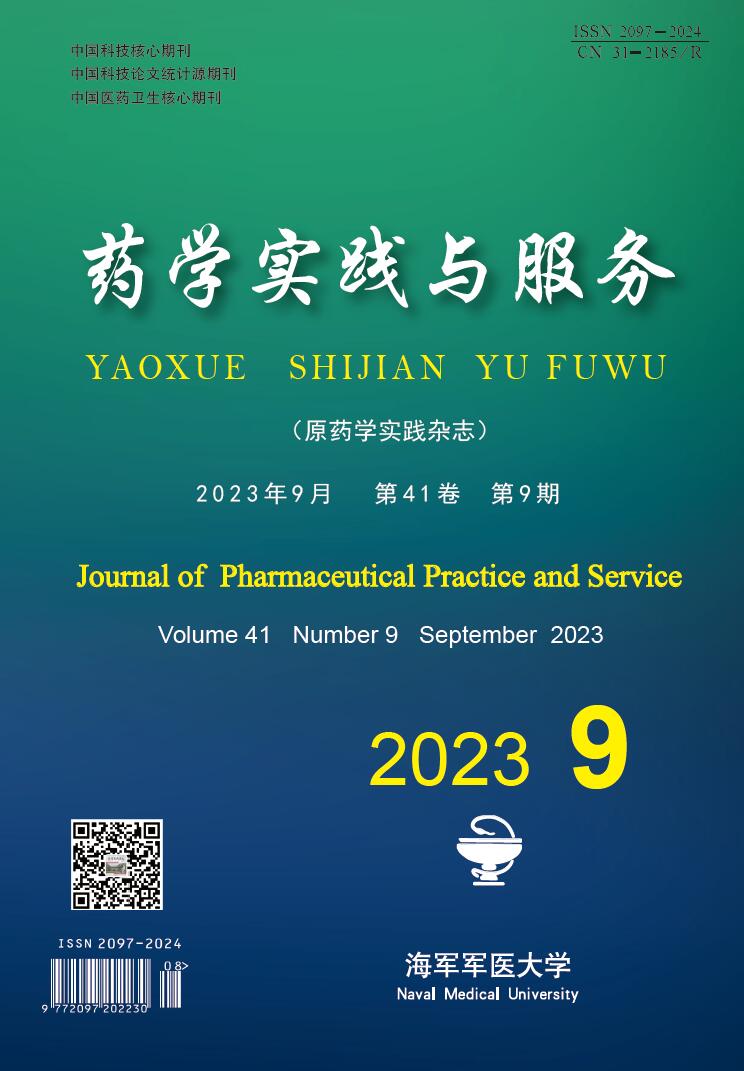-
心房颤动(房颤)是最常见的心律失常之一。据统计,成年人房颤患病率在2%~4%,并且随着年龄的增长不断提高[1]。非瓣膜性心房颤动(NVAF)社区人群发病率为0.1%~4%、住院人群发病率为2.8%~14%[2],研究显示[3]70%以上的NVAF发生人群为65岁及以上老人,其发生率与年龄增加呈正相关。作为中风的独立危险因素,房颤可使包括中风在内的主要心血管事件风险增加5倍[4],因此,合理的抗凝可以降低老年人群中风及其他心血管事件的风险。
新型口服抗凝药达比加群酯可以直接抑制凝血酶,能够可逆性、竞争性地与凝血酶Ⅱa结合,阻止纤维蛋白原转化为纤维蛋白,从而抑制血小板聚集。达比加群酯口服吸收快,口服后有80%以原形通过肾脏排泄,其余经肝脏代谢,并且经P450酶系代谢的药物不会与其产生相互作用[5]。但是随着达比加群酯在临床上的广泛应用,其引起的出血等不良事件也越来越多,而老年人由于肝肾功能退化,成为了血栓和出血的高危人群[6-7],因此,对于达比加群酯在老年非瓣膜性房颤患者中安全性研究愈加重要。
-
收集2020年12月至2021年6月上海市第七人民医院门诊和住院的非瓣膜性房颤患者的临床资料,年龄65~80岁,在其他常规对症治疗基础上,选择达比加群酯胶囊抗凝治疗(110mg/片×10片/盒,勃林格殷格翰公司)。用法:110 mg,口服,每天2次(早、晚各1次),治疗6个月。
本方案经医院伦理委员会批准通过,所有入组患者及其家属对治疗方案均知情并签署知情同意书。
-
纳入标准:①符合欧洲心脏病学会2010年《心房颤动管理指南》中非瓣膜性房颤的诊断标准;②心脏超声检查排除退行性瓣膜病及风湿性心脏病等瓣膜性心脏病;③既往未进行过规范化抗凝治疗,无抗凝禁忌证,血常规及凝血时间均在正常参考值范围内,尿便隐血阴性;④入选前6个月内未发生任何卒中。
排除标准:①急性冠状动脉综合征及冠状动脉介入术后1年、心包炎、心肌炎、甲状腺功能亢进症、严重肺部疾病、肝酶异常及肌酐清除率(Ccr)≤30ml/min者;②对本研究药物过敏或不能随访或中途更换抗凝药者。
-
入选患者于入院后24h内统一抽取静脉血送检。实验室观察指标:包括活化部分凝血活酶时间(APTT)、血浆凝血酶时间(TT)、纤维蛋白原(FIB)和D-二聚体(D-D);肝功能指标包括谷草转氨酶(AST)、丙氨酸氨基转移酶(ALT)、总胆红素(TBIL);肾功能指标包括尿素(UREA)和肾小球滤过率估计值(eGFR);血常规指标包括血红蛋白量(HGB)、红细胞沉降率(ESR)。观察服药1个月后、6个月后与治疗前相比的各项指标变化。
-
根据指南要求在治疗前对所有研究对象进行血栓栓塞及出血风险评估。血栓栓塞风险采用CHA2DS2-VASc评分进行评价[8]:年龄65~74岁计1分,慢性心衰计1分,高血压计1分,年龄≥75岁计2分,糖尿病计1分,卒中/短暂性脑缺血发作计2分,血管病计1分,女性计1分。CHA2DS2-VASc≥2分的患者推荐使用口服抗凝药物(OAC);CHA2DS2-VASc为1分的患者口服OAC或阿司匹林,但更倾向OAC;CHA2DS2-VASc为0分可服用阿司匹林或者不进行抗栓治疗。出血风险评估采用HAS-BLED评分进行评价[9]:有未控制的高血压,即SPB>160mmHg计1分,肾功能异常(长期透析或肾移植或血清肌酐≥200μmol/L)或肝功能异常(慢性肝病或胆红素>2倍同时转氨酶>3倍)计1或2分,卒中计1分,既往出血史或出血体质、贫血等计1分,INR不稳定计1分,老年(即年龄>65岁)计1分,药物(同时应用抗血小板药和非甾体抗炎药)或酗酒计1分。HAS-BLED评分≥3分为出血高危组,启动OAC或阿司匹林治疗后均须密切随访。不良事件统计采用随访的方法,统计时长共计6个月,记录药物相关不良事件的发生率。
-
采用SPSS 21.0软件进行数据分析,正态分布计量资料以(
$ \bar x \pm s $ )表示,组间比较采用单因素方差分析和t检验,以P<0.05表示差异有统计学意义。 -
按照入选标准和排除标准共收集病例80例,男性45例,女性35例,年龄(76.0±0.8)岁,CHA2DS2-VASc评分(4.1±0.2),HAS-BLED评分(2.5±0.1),主要相关症状见表1。
其他相关症状 病例数[n, (%)] 高血压 57(71.25) 糖尿病 22(27.50) 冠状动脉粥样硬化 49(61.25) 心律失常 33(41.25) 脑梗死 5(6.25) 高尿酸血症 1(1.25) -
患者服药后1个月、6个月的APTT和TT分别与服药前比较,差异有统计学意义(P<0.05);且服药6个月与服药1个月比较,差异亦有统计学意义(P<0.05)。FIB和D-D与服药前比较差异无统计学意义(P>0.05),见表2。
组别 APTT(s) TT(s) FIB(g/L) D-D(mg/L) 服药前 34.37±0.59 19.98±0.45 3.17±0. 08 0.85±0.03 服药1个月 39.99±1.18* 75.30±7.38* 3.48±0.13 0.84±0.03 服药6个月 51.08±1.78*# 90.79±8.36*# 3.34±0.10 0.83±0.02 *P<0.05,与服药前比较;#P<0.05,与服药后1个月比较 -
患者服药后1个月、6个月的ALT、AST、TBIL分别与服药前比较,差异无统计学意义(P>0.05),见表3。
组别 ALT(U/L) AST(U/L) TBIL(µmol/L) 服药前 20.85±1.22 24.38±0.95 16.31±0.64 服药1个月 22.37±1.83 25.27±1.47 17.58±1.05 服药6个月 25.86±3.23 26.29±1.06 17.96±0.79 -
患者服药后1个月、6个月的UREA、eGFR分别与服药前比较,差异无统计学意义(P>0.05),见表4。
组别 UREA(mmol/L) eGFR[ml/(min·1.73m2)] 服药前 6.42±0.39 106.3±1.273 服药1个月 7.16±0.51 105.2±2.310 服药6个月 7.51±0.44 104.4±2.687 -
患者服药后1个月、6个月的HGB、ESR分别与服药前比较,差异无统计学意义(P>0.05),见表5。
组别 HGB(g/L) ESR(mm/h) 服药前 138.20±1.96 17.38±1.36 服药1个月 143.20±3.22 19.90±2.05 服药6个月 146.30±3.76 20.94±2.00 -
患者服用达比加群酯后共发生25例不良事件,其中胸闷9例,牙龈出血10例,消化道出血1例,血栓形成3例,脑卒中2例,分别占全部病例的11.25%、12.5%、1.25%、3.75%和2.50%。
-
2013年欧洲房颤指南[10]指出APTT谷值高于正常值上限2倍具有较高出血风险;Chin等[11]研究认为TT可作为服用达比加群酯治疗患者的监测指标,并可根据此指标的反馈来调节达比加群酯的剂量。另有研究显示[12],老年患者服用达比加群酯后,APTT和TT较用药前有所增加,达比加群酯剂量、患者肌酐清除率、合用P-gp抑制剂等均可影响APTT;但是不同个体间APTT波动较小,而TT个体间差异大,因此,可将APTT作为监测达比加群酯抗凝疗效的指标,TT作为抗凝疗效监测的补充指标。
纤维蛋白原(FIB)是凝血过程中的主要蛋白质,Lindahl等[13]研究认为FIB的影响因素较多,与达比加群酯的凝血活性并没有太大关系。本研究也显示该指标受达比加群酯的凝血活性影响不大,因此,可不考虑FIB的变化。
服用达比加群酯后1个月、6个月患者的凝血功能指标(APTT、TT)与服药前相比差异有统计学意义,且数值有升高趋势,提示达比加群酯可改变患者凝血功能,对预防和治疗老年非瓣膜性房颤患者血栓形成有效。通过研究发现,患者凝血功能指标在治疗6个月后与治疗1个月后相比,数值有升高的趋势。笔者分析可能原因有两方面:一是与患者用药依从性有关,同年轻人相比,老年人往往合并多种慢性疾病,因此需要同时服用多种药物,此时用药的依从性至关重要。兰博等[14]对老年人心血管用药现状调查发现,老年人使用降脂药的依从性与老年人的年龄及文化程度显著相关,其依从性仅为49. 2% ,原因主要为慢性病用药观念不强及初始治疗时忘记服药,随着时间的延长以及研究者推进,用药依从性逐渐好转,因此出现6个月后凝血功能指标数值升高的趋势;二是与抗凝药物的使用有关,根据实验结果,达比加群酯可改变老年患者APTT和TT水平[15-17]。
服药1个月、6个月后患者肝功能指标(ALT、AST、TBIL、D-D)、肾功能指标(UREA、eGFR)与服药前的差异无统计学意义,提示达比加群酯对肝肾功能无明显的毒性作用;服药1个月、6个月后患者血常规指标(HGB、ESR)在服药前后差异无统计学意义,提示达比加群酯对患者血红蛋白量、红细胞沉降率无显著影响。
患者服药后的不良事件主要表现为胸闷、 牙龈出血、 消化道出血 、血栓形成和脑卒中,并未发生严重出血和威胁生命或器官衰竭的出血。不良事件中较为严重的事件包括3例血栓形成和2例脑卒中发生,分析这5例患者发现,2例血栓形成患者均存在血脂控制不良现象,1例体重较大,考虑血栓形成与血脂控制不良和极端体重相关;2例脑卒中患者年龄分别为75岁和80岁,属高龄患者,考虑高龄患者肾功能减退,从而导致血药浓度增加[18]。近期国内外Meta分析[16-18]也显示达比加群酯出血事件少、使用安全。因此,基于目前的研究数据,可以认为达比加群酯对老年非瓣膜性房颤患者的安全性良好,适于老年患者使用。
Efficacy and safety evaluation of dabigatran etexilate in the treatment of elderly non-valvular atrial fibrillation
doi: 10.12206/j.issn.2097-2024.202207029
- Received Date: 2022-07-08
- Rev Recd Date: 2023-04-04
- Available Online: 2023-09-25
- Publish Date: 2023-09-25
-
Key words:
- dabigatran etexilate /
- nonvalvular atrial fibrillation /
- efficacy /
- safety
Abstract:
| Citation: | LI Ting, SHI Kourong, LI Zhi, WANG Ziyu, CAO Ailin, QIAN Jiao. Efficacy and safety evaluation of dabigatran etexilate in the treatment of elderly non-valvular atrial fibrillation[J]. Journal of Pharmaceutical Practice and Service, 2023, 41(9): 557-560. doi: 10.12206/j.issn.2097-2024.202207029 |









 DownLoad:
DownLoad: